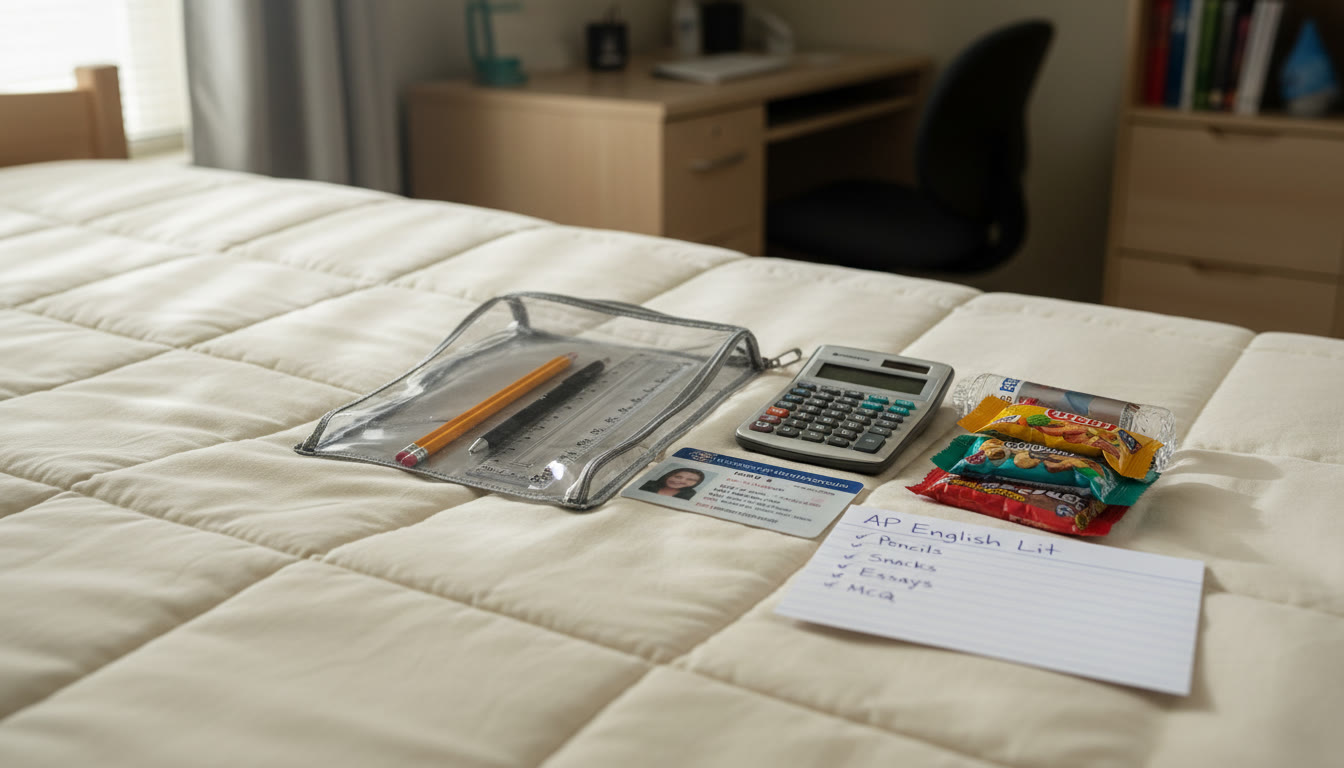Last-Minute Triage: Secure Easy Points First
There’s a special kind of hush the week before an AP exam — textbooks stacked like nervous towers, sticky notes sprouting from notebooks, and a steady loop of practice questions that somehow both comforts and terrifies you. If you’ve got limited time and a long to-do list, the smartest move isn’t to sprint through every topic at once. It’s to triage: prioritize the easiest, highest-value wins first so you can guarantee points, build momentum, and arrive on test day calm and confident.

Why triage beats panic
Panic makes you flit from one topic to another, skimming without mastery. Triage, on the other hand, is surgical. You identify items that are quick to secure — straightforward multiple-choice questions, predictable free-response structures, formulas and facts you can memorize fast — and you lock them in. That approach delivers immediate score benefits and reduces cognitive load, leaving mental space to tackle trickier material if time allows.
Think of your remaining time as a set of precious test tickets. Each ticket should be spent where it yields the biggest return — not on re-learning an entire unit from scratch but on turning 50/50 guesses into sure things and polishing the parts of free-response rubrics you can reliably satisfy.
First triage target: Multiple-choice wins
Most AP exams include a multiple-choice (MCQ) section that contributes a large chunk of your overall score. These questions are often the most efficient to improve quickly because they reward clarity, elimination techniques, and pattern recognition.
- Review commonly tested formulas and vocabulary: One or two flashcard sessions can turn a shaky memory into instant recall. For math and science exams, make a one-page formula sheet (for study use only) and drill it before practice sets.
- Master elimination strategies: For 4- or 5-choice questions, practice identifying obviously wrong answers first. Even if you can’t deduce the correct answer immediately, eliminating two choices dramatically raises your odds.
- Use timing drills: Simulate paced segments: if the section is 60 minutes for 55 questions, practice at that pace. Learn which question types slow you down and which you can blast through for reliable points.
- Handle diagram/data prompts: Many questions are based on a shared stimulus. Read the question before diving into the stimulus to know precisely what to look for and avoid re-reading things you don’t need.
Practical MCQ exercise for the last week
Set aside three focused sessions in the final week:
- Session 1: Untimed review of 20 past MCQs to identify question patterns you frequently miss.
- Session 2: Timed 25-question sprint to practice elimination and pacing.
- Session 3: Mixed practice with emphasis on any weak content areas discovered in Session 1.
Secure the free-response fundamentals
Free-response questions (FRQs) often intimidate students because they feel open-ended. In reality, AP FRQs are structured and scored by rubrics. That means if you meet the rubric’s requirements, you earn points — even if your writing isn’t poetic or your solution isn’t the most elegant.
Work the rubric, not the perfection
Read the rubric language for your subject and distill it into a checklist you can apply under time pressure. For example:
- List what earns the method/approach points (showing steps, labeling axes, providing units).
- Identify what earns the justification/analysis points (state assumptions, explicitly connect steps to conclusions).
- Spot the single most common point students miss and practice avoiding it.
Rubrics are mercifully literal. If a rubric awards a point for “showing the calculation,” then show the calculation, even if you’re convinced your arithmetic is obvious. Don’t leave marks on the board that graders can’t credit.
A quick FRQ checklist to carry into the exam
- Read the prompt twice; underline exactly what’s asked.
- Write a one-sentence plan before you start solving.
- Label every axis/table and include units.
- Box or circle final answers and include units or brief justification sentences.
- If you’re stuck, write what you would do next — partial methods are often worth points.
30/60/90: A last-week schedule that actually works
Here’s a practical time-allocation plan you can adapt to your remaining days. The idea is to prioritize high-yield tasks in short, focused bursts so you don’t burn out.
| Time Block | Focus | Goal |
|---|---|---|
| First 30 minutes (daily) | Flashcards / Formula review | Lock immediate recall for essential facts |
| Next 60 minutes | Targeted MCQ practice | Convert guesswork into sure answers |
| Next 90 minutes | One FRQ or extended problem | Practice rubric alignment and clear explanation |
| Final 30 minutes (wrap-up) | Review mistakes and write a 3-step plan for tomorrow | Solidify learning and reduce next-day friction |
Repeat this block once or twice depending on your stamina and time available. Consistency trumps marathon cramming.
One-week intensifier
If you’re seven days out, reserve two full-length practice sections under timed conditions (one MCQ block and one FRQ block) and otherwise use the 30/60/90 approach for daily drills. If you’re three days out, cut lengthier drills and focus on quick wins: flashcards, rubric checklists, and practice that reinforces strategy rather than learning new content.
Exam-day triage: smart moves to start strong
The first 15 minutes of the exam set the tone. Use them intentionally.
Before opening the booklet
- Take three deep breaths to settle adrenaline.
- Quickly scan the MCQ section to spot any passages or blocks you can answer rapidly.
- Mark the questions you’re confident on and answer them first. If you have to guess, eliminate options and move on — you can return if time allows.
If you hit a wall on an FRQ
Don’t stare. Write what you know. A brief, correct method with partial steps is often worth more than a polished but empty paragraph. Keep the rubric in mind: show your work, state assumptions, and label clearly. If you can’t finish a derivation, at least outline the steps you would take — graders will award method points if they can follow your logic.
Common last-minute traps and how to avoid them
Trap 1: Over-reviewing one topic
You might convince yourself that mastering the one chapter you hate will fix everything. In reality, obsessing over a low-yield topic is inefficient. Instead, focus on coverage: ensure you can answer common questions across the test’s major themes. If a topic is truly necessary, add a tiny daily drill rather than all-night immersion.
Trap 2: Ignoring the instructions
It’s astonishing how many points are lost because a student forgot to label axes, include units, or show work. Read the directions for every section and follow formatting rules. Those are free points waiting to be collected.
Trap 3: All-or-nothing perfectionism
Perfection doesn’t win points; meeting rubric requirements does. If an essay needs three components to earn full credit and you can convincingly supply two, do that cleanly and clearly rather than attempting a grand sweep that ends up messy or incomplete.
Examples: How triage turns problems into points
Example 1 — Chemistry MCQ: You see a question that asks which reaction will produce the greatest pressure increase. Rather than re-deriving kinetic relationships, scan answer choices for clear red flags (non-gaseous products, pressure-irrelevant changes). Eliminating two choices often leaves the right answer obv ious.
Example 2 — History Free Response: A prompt asks you to analyze the causes of a policy. Instead of writing a long, undirected essay, use a three-paragraph structure: context (one sentence), two cause paragraphs each with an example and a short analysis, and a one-sentence conclusion linking back to the prompt. This satisfies likely rubric bullets and keeps your argument tight.
Use practice tests strategically — not slavishly
Full-length exams are invaluable for pacing and stamina, but in the final stretch you should choose quality over quantity. One authentic practice test under timed conditions is worth more than three half-hearted attempts. After a full test, spend time analyzing every missed question: why you missed it, what trap you fell into, and how to avoid it. Then create a micro-plan to fix that specific weakness.
How to analyze mistakes fast
- Write the error type next to each wrong answer (Careless, Concept Gap, Misread, Calculation).
- For each Careless mistake, commit to a simple fix (double-check units, underline key words).
- For Concept Gaps, pick one 20-minute focused review session and a single practice problem.
Tools and small rituals that stabilize performance
Little rituals can anchor you when nerves spike:
- Bring a tiny notecard with a one-line breathing routine or cue word for calm.
- Have a standard way to mark questions during MCQ (e.g., circle for confident, box for revisit) to avoid wasteful re-scans.
- Use a two-step checking routine for FRQs: quick math check immediately after finishing each part, and a one-minute re-read before moving on.
When to call for help — and how personalized tutoring can help in the final stretch
If you’re stuck and time is tight, a short, focused tutoring session can be transformative. A tutor can quickly identify whether a gap is conceptual or strategic and give you targeted practice that yields immediate returns. Sparkl’s personalized tutoring model — 1-on-1 guidance, tailored study plans, and AI-driven insights to pinpoint your weak spots — is especially useful for last-minute triage because it replaces generic advice with an action plan focused on your specific exam and score goals.
Book a short session to:
- Practice exam strategies live and get instant feedback on FRQ structure.
- Clarify one or two stubborn concepts so you can stop guessing and start answering confidently.
- Refine your pacing and develop a final-day checklist you’ll actually follow under stress.
Mindset: small wins compound
Triage is as much a mental strategy as it is academic. Early wins — a batch of correct MCQs, a cleanly scored FRQ in practice — create momentum. They reduce anxiety and give you the cognitive bandwidth required for tougher problems. Celebrate those wins quietly. They are the engine of performance.
Remember: exams favor clarity and consistency over brilliance in one isolated moment. A thoughtfully solved simple question plus a clearly organized FRQ usually beats a half-sketched brilliant insight that a grader can’t parse.
What to do the night before and the morning of
The night before
- Do a light review: 30–45 minutes of flashcards or a short practice set — nothing new.
- Prepare logistics: photo ID, allowed calculator and batteries, pencil/pen extras, watch (if allowed), and a printout of your testing center directions.
- Set a bedtime routine: screens off at least 60 minutes before sleep, a warm drink if it helps you relax, and a brief breathing exercise.
The morning of
- Eat a balanced breakfast with protein and complex carbs.
- Do a 10-minute light review of a one-page formula or a list of key dates/terms — something that feels empowering but not cramming.
- Arrive early, avoid last-minute group panics, and do three deep breaths before you enter the room.
Final checklist: last-minute triage cheat sheet
- Secure MCQ points first — answer what you know, then eliminate choices, then guess if needed.
- Follow FRQ rubrics exactly — show work, label, include units, and box final answers.
- Prioritize practice that builds quick recall (flashcards) and strategy (timed sections).
- Use one focused tutoring session if uncertainty persists — it’s often the fastest way to convert weakness into points.
- Sleep, hydrate, and keep rituals simple the night before and the morning of.

Parting thought: practice for the test, prepare for yourself
AP exams are a test of both knowledge and composure. Triage is not a shortcut; it’s a smart allocation of your remaining resources. By capturing easy points first — through efficient MCQ strategies, rubric-driven FRQs, and targeted review — you reduce uncertainty and give yourself the best shot at the score you want.
When you’re in that final stretch, be kind to yourself. Replace the chatter of “what ifs” with a simple plan: secure the sure points, polish the high-yield skills, and show up ready. That combination is, more often than not, the difference between a stressful scramble and a composed performance that reflects your real ability.
Good luck — you’ve got this. And if you want a final, focused session to triage your study plan and turn weak spots into quick wins, consider a targeted tutoring session with Sparkl for a short, tailored boost that fits right into the last-minute timeline.




















No Comments
Leave a comment Cancel